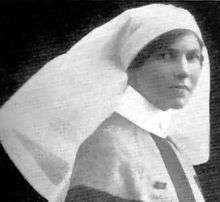Catherine Black (nurse)
| Catherine Black | |
|---|---|
 | |
| Born |
1878 Ramelton |
| Died | 7 October 1949 (aged 70–71) |
| Known for | Nurse to King George V |
|
Medical career | |
| Profession | Nurse |
| Institutions | Royal London Hospital |
| Specialism | Field hospital nursing |
Catherine Black (1878–1949) MBE, RCC, SRN, also known as "Blackie", served in World War I and as the private nurse to King George V.
Family and early life
Catherine Black was born in 1878 in Ardeen House, Ramelton, County Donegal in Ardeen House on the outskirts of the town.[1][2] Her father was a linen draper with a prosperous shop in the town.[3] Black went to Royal London Hospital to train as a nurse, and it was whilst there that she became friends with Edith Cavell.[4] She died on 7 October 1949 in London.[2]
WWI service
Black was working as a private nurse in Royal London Hospital when the outbreak of World War I was declared.[5] She joined Queen Alexandra's Imperial Military Nursing Service, first serving in Cambridge Hospital in Aldershot and then the No. 7 Hospital in St Omer where she treated soldiers suffering from shell shock.[5] Black was then sent as a replacement for a nurse who was killed at a casualty clearing station at Poperinghe, Belgium, and subsequently went on to serve at the 41st Stationary Hospital at Sailly-Lorette, nursing soldiers with self-inflicted wounds. She was moved to the No. 5 General Hospital in Rouen and various other clearing stations until the end of the war.[5]
King George V
Sister Black was the private nurse of King George V from 1928 until his death in 1936.[1] She began her service in late 1928 following a serious bout of illness for the King.[6] Black was made permanent in 1930; she was given her own chambers within Buckingham Palace.[7] She was known as "Blackie" to the members of the royal family.
Black objected to the actions of the King's doctor Lord Dawson of Penn in administering a lethal combination of morphine and cocaine to hasten the King's death.[8][9][10] The King's final words, "God damn you!", were addressed to Black as she gave him a sedative on the night before his death.[8]
Black wrote of her life in the Palace in her autobiography King's Nurse, Beggar's Nurse, in which she also recounted her childhood in Donegal,[11] nursing in Australia, as well as her service in WWI.[1] In reflecting on the experiences of nurses in the war, Black recounted "you went into [a casualty-clearing station] young and light-hearted. You came out older than any span of years could make you."[12]
References
- 1 2 3 "Catherine Black". Ramelton. Retrieved 20 February 2015.
- 1 2 "1916 Education Study Pack" (PDF). Donegal County Council. Retrieved 18 February 2016.
- ↑ "Nurse Catherine Black writes about her childhood in Ramelton in the late 1800's From her book 'King's Nurse, Beggar's Nurse'". Ramelton Tidy Towns. Retrieved 20 February 2015.
- ↑ Newman, Vivien (2014). We Also Served: The Forgotten Women of the First World War. Pen and Sword. pp. 159–160. ISBN 9781473845275.
- 1 2 3 Cook, Bernard A. (2006). Women and War: A Historical Encyclopedia from Antiquity to the Present. California: ABC-CLIO. pp. 65–66. ISBN 9781851097708.
- ↑ Edwards, Anne (2014). Matriarch: Queen Mary and the House of Windsor. London: Rowman & Littlefield. ISBN 9781442236561.
- ↑ "History". Ardeen House. Retrieved 20 February 2015.
- 1 2 Watson, Francis (1986), "The Death of George V", History Today, 36: 21–30
- ↑ Ramsay, J. H. R. (28 May 1994), "A king, a doctor, and a convenient death", British Medical Journal, 308 (6941): 1445, doi:10.1136/bmj.308.6941.1445, PMC 2540387
 , PMID 11644545 (Subscription required)
, PMID 11644545 (Subscription required) - ↑ Williams, Kate (2012). Young Elizabeth: The Making of our Queen. UK: Hachette UK. ISBN 9780297867821.
- ↑ "Catherine Black". Ramelton Tidy Towns. Retrieved 20 February 2015.
- ↑ "1918 The Great War: Quotations". 1918: Ireland and the Great War. Retrieved 20 February 2015.